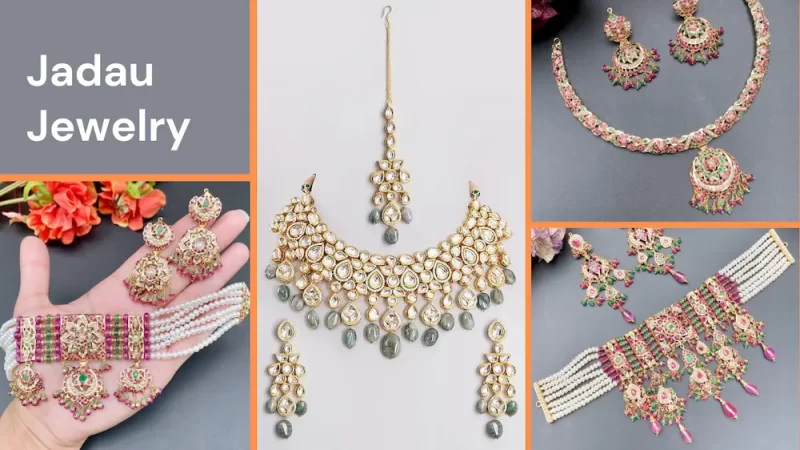We are aware of the differences between diamonds and Swarovskis, but are you aware of polki from Kundan? How many of us can tell what work is in a photo of a wedding necklace without being in awe? So that everything is obvious, we’ve chosen to quickly outline the best types of Indian jewellery and how much they range in price for you. It is after all one of the most important investments you will ever make!
1. Describe Polki Jewellery

In essence, polki is a stone. Genuine uncut diamonds are used to make polki jewelery. Polki is an unpolished diamond that was extracted from the ground without the use of chemicals or other enhancements. The back of the gold foil used to make polki jewelery is sprayed gold to help distinguish the uncut diamonds between each stone by radiating light. Due to its high demand in the market and near untouchedness, it is costly because it is raw. Necklace collections therefore begin at around four lakhs and go higher. Because of the weight of the unpolished stones, it is also quite weighty to wear; keep that in mind as you choose it.
2. Describe Kundan Jewelry

With layers upon layers of stone, valuable metals, and meticulous joint work, Kundan jewellery is incredibly intricate. These objects have enamelled undersides. The precious and semi-precious polished jewels that are set in layers upon layers of designs are what make Kundan jewellery distinctive. Kundan refers to highly polished, pure gold, but modern jewellery is fake Kundan that looks like pure Kundan but is not made of gold.
The price of handcrafted Kundan jewellery made with real gold and jewels ranges from 50,000 to several lakhs of rupees. In addition, there are fake ones in the Rs. 1000 pastureland.
3. What Distinguishes Kundan Jewelry from Polki?

Both Kundan and Polki are rocks. Kundan jewellery is made from glass and jewels, whereas Polki is made entirely from unpolished, natural diamonds.
Traditional Rajasthani jewelery known as “Kundan” is composed of glass and stone. (glass polki). Typically, Kundan is less costly than Polki because it uses inlaid stones rather than metal. The only difference in luminosity between Polki and Kundan’s faces is that Polki is more refined than Kundan. Additionally, because they are artificial stones, they are much lighter.
4. How Does Jadau Jewelry Work?

Jadau is a common method used to make Kundan or polki, despite the fact that many people think of it as a kind of stone or ornament. Thus, Jadau is a process used to create Kundan/Polki jewelery while Kundan and Polki are both gemstones. The technique used by craftsmen to create this jewellery design, known as “Jad,” means to be firmly established. Jadau’s work is intricate and involves a group of artisans who must have a thorough understanding of it. Making the jewelery requires a lot of work; setting just four or five stones can take an entire day. It is one of the most costly types of jewels as a result. Each craftsman is assigned a particular job. The ornament’s initial form is determined by the parameters. The ghaarias, or engravers, create the engravings and the marks that are necessary for subsequent embedding. As we said, the goal of this method is to ingrain stones. Just enough gold is dissolved to make it malleable. The stones or gemstones are then placed on it once it has reached that state. To complete this task precisely, care and precision are required. The crystals or jewels adhere to the metal without any assistance once it has cooled.
5. Consider Meenakari Jewelry

Meenakari is the practise of using brilliant hues combined with complex designs to colour and embellish the surface of metals. Meenakari is the term for the coloured enamel you see when there is a lot of paint on a jewellery piece. This is also located in the rear of your polki spot. Meenakari has a long history with the native Kundan necklace design of Rajasthan. The Meenakari position is reasonably priced because the gold range is small and the lac used is only enamel.
These days, meenakari job chances are also available in artificial jewelry, which makes it very affordable if you’re looking for low-cost alternatives.
How is Temple Jewelry any different from all of this?
Very distinctive! As the name implies, temple gold was used to decorate the gods and goddesses represented in south Indian culture. They are weighty and lumpy, frequently set with jewels or even made of pure gold.
South Indian society frequently influences the patterns of temple jewellery online. Idols of animals, birds, flowers, and regal characters as well as gods and deities inspired them. Temple gold has a vintage appeal due to its extensive cultural heritage. It was expensive because it is constructed of solid gold and is quite large.
Tips For Taking Care Of Your Wedding Jewelry
To prevent the pieces from rubbing against one another, store gold jewels in a case with sections that are lined with satin or velvet.
Keep jewelery made of meenakari or jadau in sealed plastic containers.
Airtight containers should be used to keep silver jewellery in order to limit contact to metals and oxygen.
Never apply cosmetics or scent after wearing jewellery; always do so first.
Keep gemstone-containing jewellery in distinct, plush pouches that you can get from your jeweller. When choosing your jewelry, always request extra so you can keep it individually.
Polki jewellery should be protected from dampness by being wrapped in butter paper or cotton and kept in a cold, dry environment.











Leave a Reply